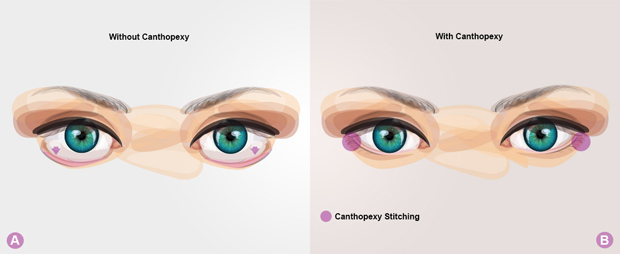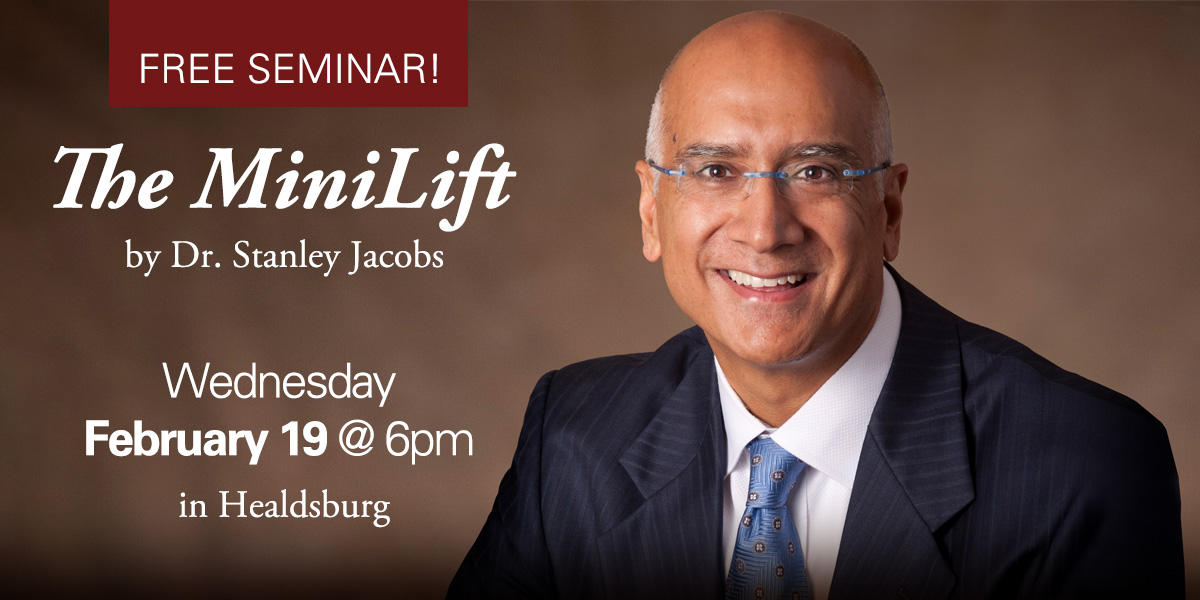Each year, 100,000 men and women tired of looking older, suffering from impaired vision, or both choose to correct the source of their problem—droopy eyelids—with a blepharoplasty. Our surgical team provides eyelid surgery for patients in Santa Rosa, Healdsburg, and other Bay Area communities, restoring proper visual function and helping them to regain a younger appearance.
There are generally two types of blepharoplasty: upper lid and lower lid. They may be performed separately or together, depending on the patient’s preference and needs. While the upper eyelid surgery tends to address droopiness, lower lid work frequently serves to remove puffiness and bags found under the eyes that make you look worn and tired. A lower lid blepharoplasty can also eliminate fine lines and drooping in the area.
If you’re wondering how blepharoplasty can change the way you look, you need to know how the eyelids function, how time impacts them, how eyelid surgery is performed, and what you can expect from the procedure. Our surgeons regularly explain to patients that blepharoplasty, better known as eyelid surgery, is not a single procedure, but the blanket term for surgical improvement made to the upper eyelids, the lower eyelids, or both.
As noted above, the two eyelids, upper and lower, work together as a team, but age and changes to the skin impact them differently. An excess of tissue can cause problems, especially if it is lax and sagging. Since gravity steadily pulls tissue downward, the upper lid begins to droop and alter the contours there. The drooping skin on the upper lid creates a look associated with tiredness, disinterest, and sadness. In certain cases, the skin can block the field of vision, causing a distraction or even partial obstruction of a clear field of view. The lower lid begins to do the opposite, pulling away to expose more of the white of the eye in the area below the iris, and creating wrinkles and pouches.
To correct these changes, blepharoplasty removes excess fat, muscle, and skin from the lids. The results of a blepharoplasty can yield a refreshed appearance, with a younger, firmer eye area. Patients feeling alert and happy will actually look alert and happy, and in some cases, visual impediments due to drooping skin will be eliminated.
Since upper and lower lids can be worked on independently of each other (with each surgery yielding distinct results), our surgeons work with patients, starting at the eyelid surgery consultation, to determine the best possible aesthetic outcome. Based on a patient’s responses, the surgeon may recommend blepharoplasty for the upper or lower lids, or the whole area.
The sagging unique to the upper eyelid requires a dedicated approach that begins with an assessment of all the skin and tissue in the area, since a drooping lid may be due to laxity higher on the face. Loose skin on the brow can slump and push the upper eyelid downward. Your surgeon can determine the source of the problem and respond accordingly. A brow lift may be necessary to correct a permanent look of fatigue, anger, or sadness. If a blepharoplasty is found to be the best option, he can make the required adjustments in a matter of one to two hours.
Below the eye, gravity can pull tissue downward, causing fat that was once firmly in place to collect in a visible pouch. Our surgeons can remove this fat, along with loose skin or muscle that has similarly sagged, creating or drawing more attention to what most people refer to as under-eye bags. Lack of sleep, fluid retention, and allergies can also give the under-eye area a puffy look, so surgery will only be recommended if the cosmetic problem is due to laxity and not temporary swelling.
Our surgeons practice a technique specific to lower-lid blepharoplasty known as canthopexy, which prevents post-surgical distortion by tightening a key structure: the canthal tendon that holds up the lower eyelid, like a belt holds up a pair of pants. This technique requires experience and skill, and is not practiced by all surgeons. Without it, however, about 30 percent of patients who get lower eyelid surgery find that the treated lid rolls outward, exposing the inner surface, in a condition known as ectropion.
Our surgeons perform canthopexy as a part of a lower-lid blepharoplasty surgeries to preemptively stop ectropion from happening. They also correct the problem for patients who developed it after having eyelid surgery performed elsewhere. In fact, Dr. Jacobs has a published medical peer-reviewed paper on this subject, titled “Prophylactic Lateral Canthopexy in Lower Blepharoplasties.”
If both the upper and lower lids need correction, a patient may choose to have one blepharoplasty procedure performed first, and then the other, or can have both handled at the same time to shorten recovery time.
Eyelid surgery is a commonly performed procedure with a track record of safety and satisfying results. Adults who are dissatisfied with the look or functioning of their eyelids and who are in generally good health are the ideal candidates for a blepharoplasty.
People with circulatory, ophthalmological, or serious medical conditions must rely on the diagnostic skills of their own personal specialists to determine whether blepharoplasty is an option for them. Consultation with our qualified plastic surgeons can help you decide whether any additional, complementary surgery would increase the success of the eyelid surgery.
Good candidates for blepharoplasty should be feeling well, and the eyelid area should be free of any infections on the day of the surgery.
Whether you’re considering eyelid surgery in the North Bay area for functional or cosmetic reasons, your choice of a qualified facial plastic surgeon should be top priority.
During the pre-surgical consultation, your surgeon will examine you and ask you to answer questions about your vision, tear production, use of lenses, and desires for surgery. The surgeon will explain what you can expect from blepharoplasty and take a complete medical history. Factors to be weighed include age, skin type, ethnic background, and degree of vision obstruction.
The typical blepharoplasty surgery can take one or two hours.
Each type of surgery begins with the administration of an anesthetic to reduce sensation in the area and maximize the patient’s comfort.
Since the eyes are such a focal point, our surgeons begin each eyelid surgery session by marking where the incisions will go, taking care to place them in the creases and folds of the upper eye so that any faintly visible scars will be hidden. Once the blepharoplasty incisions are made, he will use them to remove excess tissue, as well as reposition fat and muscle as necessary to better show off the natural contours of the eye. He will also cut away excess skin. Though the incisions will be camouflaged by natural lines in the skin, our surgeons still uses fine sutures that lead to better healing and less visible permanent marks in the eyelid surgery area.
Lower eyelid blepharoplasty surgery is based on the same idea, with expertly hidden incisions, though these will be located in the creases beneath the eye. The surgeon will remove skin and fat, reposition fat, and tighten tendons as necessary to keep the lower lid from pulling toward the ground, before closing the incision with fine sutures.
A transconjunctival blepharoplasty, which addresses a puffy look due to fat deposits beneath the eye, involves an incision made inside the lower lid, for those people who have no loose skin. After removing and redistributing the problem fat, no suture is required as the wound heals without a trace. This technique leaves no visible scars.

Any incisions on the outside of the eyelids may need to be covered by small strips of tape while they heal. You might feel comfortable concealing the area with sunglasses, since it will likely be bruised and swollen for a few days after your blepharoplasty, and your eyes themselves may be itchy and dry. Know that covering your eyes is not necessary from a medical perspective. Non-dissolving stitches will be removed between five and seven days after your eyelid surgery.
Keeping your head elevated throughout your blepharoplasty recovery can minimize bruising and swelling, and using cool cloths or compresses can reduce discomfort and shorten your recuperation period. You may also want to apply a product to keep your eyes and the surrounding skin and structures moist. Your surgeon will prescribe medications as necessary to patients who need help managing their comfort levels.
You will also receive instructions from our team on how to care for your eye area in the weeks after your blepharoplasty. This will include how to clean your eyes as necessary and manage any dryness or discomfort at home. The staff will also list places and activities to avoid throughout the initial weeks of your recovery.
Note that in the years after your eyelid surgery, the skin around your eyes will continue to age, but you’ll have an advantage with a blepharoplasty. Not only will you be moving forward with a newly rejuvenated look, essentially setting the clock back years for your face, but the eliminated tissues will also no longer be dragging down the skin around them.
To best ensure that your new look continues well into the future, we recommend using sunscreen as protection against skin-damaging UV radiation, as well as moisturizing products to keep the skin pliant and healthy.
Eyelid surgery obviously focuses on one very specific region of the face. While eliminating droopiness and bags can give the eye area a rejuvenated appearance, which impacts the face as a whole, it can also be used as one element of something more.
Since the blepharoplasty procedure can’t alter aesthetic problems related to skin tone, including dark circles below the eyes and fine lines and wrinkles around the eyes, our team may recommend a chemical peel to improve the skin’s texture and color.
A blepharoplasty also will not lift sagging eyebrows. This problem can be addressed by a forehead lift, which most impacts the upper third of the face. For patients interested in addressing laxity on the lower half of the face, he frequently recommends a facelift to create tighter, more defined contours.
Botox® Cosmetic can be used to temporarily smooth out crow’s feet that form to the side of either eye.
Or surgeons approach each patient’s face comprehensively, working so that every procedure, treatment, or combination of services improves the look of the face, from a solitary blepharoplasty to a total face rejuvenation.

by Dr. Stanley Jacobs
Feb 19 @ 6pm in Healdsburg
Learn more about the MiniLift and whether you would be a candidate for this exciting procedure.
